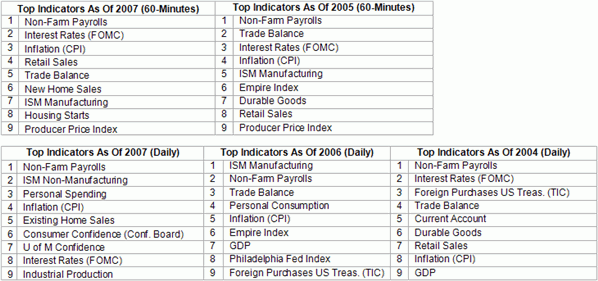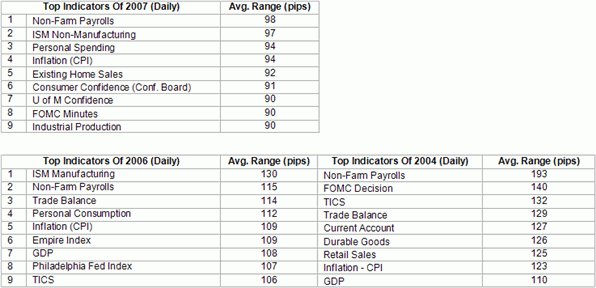| Top 5 Most Market Moving Indicators for the US Dollar |
| By David Rodriguez |
Published
03/19/2008
|
Currency
|
Unrated
|
|
|
|
Top 5 Most Market Moving Indicators for the US Dollar
When it comes to the currency market, most traders will use either technical or fundamental analysis or a combination of both to formulate their strategy, however, even for the casual currency trader, news or event risk can have a dramatic influence on the long and short-term price action of a currency pair. In this report, we examine the 5 most market moving indicators for the US dollar (we update this report annually) against the Euro. The reason for our focus on the EUR/USD is its status as the most actively traded - and therefore benchmark – currency pair.
Economic Data is Important for Both Fundamental and Technical Traders
It is irrefutable that news or economic data can elicit a sharp reaction from currencies and other financial markets. However not all economic data is created equal. The monthly Non–farm payrolls for example has had a far bigger impact on the US dollar than other perennial top market movers like consumer prices. Indicators rarely keep their same level of influence over a currency though; so it common to see major shifts in the top ranking from year to year. For example, over the past year, the worst contraction in the US housing market in a quarter century has led indicators like new and existing home sales to crowd out top releases from previous years – like ISM manufacturing. Also, what may create a lasting move in a currency on a day to day basis could be different from what triggers a knee jerk reaction in the US dollar. The top 5 most market moving indicators for the US dollar on a day to day basis are:
1. Non-Farm Payrolls
2. ISM Non-Manufacturing
3. Personal Spending
4. Inflation (Consumer Price Index)
5. Existing Home Sales
Unlike the other numbers, the non-farm payrolls report consistently topped the list of most market moving indicators for the US dollar. As the US economy slowed in 2007 and into 2008, the stability of the labor market was closely watched by all traders and analysts because of its broad ramifications for the overall economy.
The Volatile Short-Term
While many technical traders profess the long-term fundamentals are already represented in price action, even the most ardent chart reader has witnessed the considerable short-term impact fundamental releases have on the spot rate at some point. Looking at the statistics from 2007, one noteworthy detail is clear: the short-term or ‘knee-jerk’ reaction has steadily intensified over the past few years. Looking beyond this broad change and to the indicators that populate the Top Indicators list, half of the market movers from previous years were still stoking volatility through 2007. What’s more, for the knee-jerk, 20-minute reaction, both the stalwart NFP and FOMC rate decision have held the first and second slots respectively for yet another year. Though always released on a Friday (where price action is naturally limited as liquidity drains with the approach of the weekend), the NFP held off less inhibited consumer spending, inflation, housing and interest rate indicators. Through 2007, the dollar moved an average 61 points in the first 20 minutes after the labor report. This compares to a 57-point reaction through 2006.

While the knee-jerk reactions can be dramatic, its measurement also comes with some downfalls. Many times, a sharp and quick response to a specific economic release can just as quickly be retraced. However, this was not the case with many of the indicators that filled out the top nine spots in the 60-minute list. The ability of these indicators to generate follow through suggests they have a lasting influence on the US dollar and are not just open to a quick adjustment to account for fundamental surprises. It is interesting to note that the top four indicators of the 20-minute reaction list are the same as the top four on the hour-reaction list. From there, the trade balance and ISM manufacturing reports, which were absent on both the Daily and 20-minute charts, won notable spots.

The Fundamental Traders’ Top List
Though less important for the very short-term technical trader, the day to day reaction in price to fundamental indicators is still very important for traders of all means. Once again, we note that the employment report has taken the top spot. As a leading indicator for the consumer sector (for confidence and spending), business health (with investment in labor) and interest rates (through spending and inflation), the payroll number can be viewed as a relatively objective gauge of the general health of the economy.
Beyond the non-farm payroll’s consistency, however, there are few fundamental trends that have held up to the test of time. The most remarkable change between our daily measurements in 2007 and previous years is the drop in positioning for the FOMC rate decision. While the beginning of the year was relatively uneventful for policy, the final months brought about a dramatic shift in the monetary authority’s policy stance. Considering this late in the year shift, the rate decision is likely to regain its place near the top through 2008.
Aside from the demotion of the FOMC’s rate decision on the fundamental list the presence of housing numbers on all three time frames’ is testament to the influence of the subprime crisis that has infected not only the US economy but global financial markets. Another interesting observation is the ISM service’s (non-manufacturing) presence as the number two market mover. This may be a reflection of the growing fears of a US recession. Such concerns could keep this indicator near the top spot through 2008. Finally, the personal spending indicator’s unexpected rise deserves explanation. Once again this indicator is also a tie in to the health of the broader economy; and it also happens to often cross the wires the same day as the ISM factory release does.
Indicators Loosing Traction Though Volatility Heightened
Beyond the reshuffling of indicators in the rankings, it is also important to note the continued drop in daily volatility. From the daily averages below, we can see that where the non-farm payrolls report used to generate a nearly 200-point reaction in the US dollar three years ago, it has only been able to muster a 98-point drive through 2007. However, this broad change makes sense. Volatility across all the speculative markets has increased markedly as a credit crunch and fears of a looming recession have left traders highly sensitive to risk trends. So, while a fundamental release will immediately impact the dollar, the undercurrent of risk ultimately reclaims control of the dollar.

What’s In Store for the Future
While it seems that day to day news is slowly having a smaller impact on the US dollar, the top market moving indicators will still have their impact on both technical and fundamental trading. The market is highly sensitive to surprise releases from many of the more fundamentally crucial economic releases. What’s more, the cooler response to scheduled indicators over the longer term will not last. Interest in fundamentals historically goes through peaks and troughs depending on the presence of exogenous event risk. As risk in credit and other markets tempers, market participants will be more willing to take on speculative risk and respond to the ever evolving fundamental docket.
David Rodriguez is a Currency Analyst at FXCM.
|